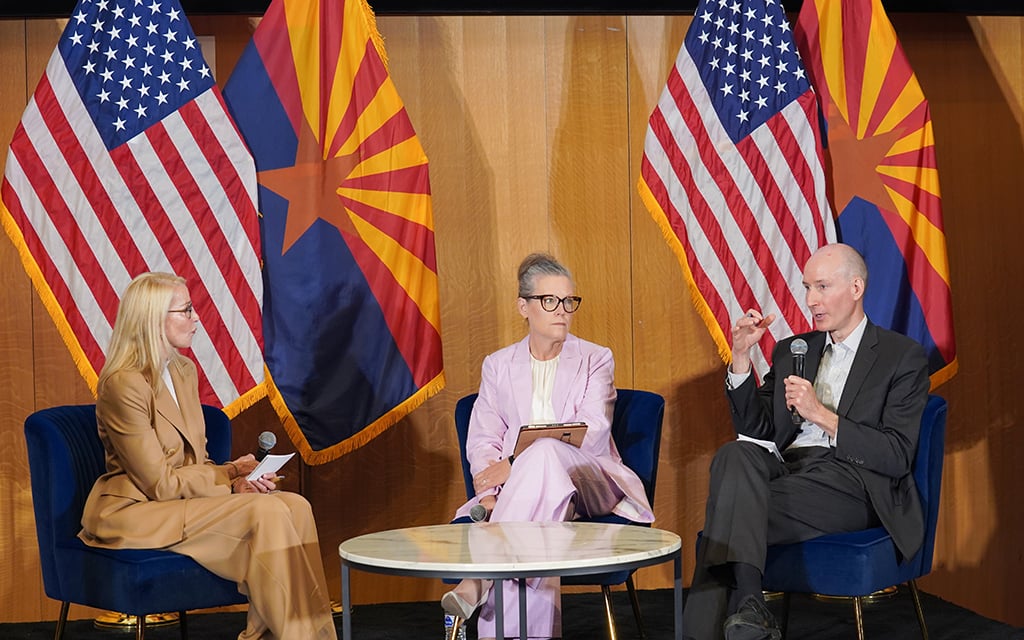WASHINGTON – The nation’s first solar-powered cobalt processing facility will break ground next year in Yuma County, a $300 million project subsidized by a big federal investment in climate-friendly projects.
The plan is one of two dozen projects underway in Arizona catalyzed by the Inflation Reduction Act signed by President Joe Biden in August 2022. The law set aside $370 billion to promote clean energy and reduce greenhouse gas emissions.
“The IRA is very helpful,” said Gil Michel-Garcia, executive vice president of EVelution Energy, which expects $42.5 million in subsidies under the IRA.
Cobalt is a key ingredient in batteries for electric vehicles. When the plant is up and running, EVelution Energy says it will process 7,000 tons worth – enough to satisfy 40% of demand for U.S. production of EVs.
The cobalt project is expected to generate 60 to 120 permanent clean energy jobs, most of which require no more than a high school diploma, Michel-Garcia said, crediting the IRA with speeding development of a domestic supply chain and providing opportunity.
“We’re shooting for probably an average salary of about $70,000 a year. So in that area it’s gonna be very attractive,” he said.
Of the 24 projects announced so far in Arizona, the biggest is a $5.5 billion battery manufacturing facility that could bring thousands of jobs to Queen Creek, though LG Energy Solution put the project on hold in July.
Arizona had 65,524 clean energy jobs at last count, according to the Department of Energy. That’s about half of all energy sector jobs in the state.
The state gained about 18,130 clean energy jobs and $11.8 billion in private investment related to the IRA in the two years after it became law, according to a report from Climate Power, a group that promotes alternatives to fossil fuels.
Clean energy refers to EVs, batteries, solar, hydrogen, wind and other renewable energy technology.
Biden routinely touts the IRA as one of his signature achievements. At the bill-signing ceremony, he projected that it would “create tens of thousands of good-paying jobs and clean energy manufacturing jobs,” many of them in communities “that have been smothered by the legacy of pollution.”
Eligible energy projects can receive a 30% tax credit for construction costs, plus a 10% bonus for projects in low-income communities. The IRA expanded the original tax credit provisions, established under the American Recovery and Reinvestment Act of 2009, by $10 billion.
The IRA also targets homeowners with incentives for installing solar panels, heat pumps, insulation and more efficient water heaters and appliances.
David Turk, deputy secretary of the Department of Energy, said the department has $295 billion in loan programs in the pipeline.

Danny O’Brien (left), executive vice president of corporate affairs at QCells, a solar cell maker, and David Turk (right), deputy secretary of the Department of Energy, discuss solar energy with homeowner Nolan Huskan (center) on Aug. 28, 2024, at a home in the Navajo Nation. (Photo courtesy U.S. Department of Energy)
Democrats championed the legislation to incentivize investments and job growth in a climate-friendly way. Most Republicans criticized it as a waste of taxpayer money.
Democrats got the IRA through Congress on party-line votes, against unified Republican opposition in both chambers. In the Senate, Vice President Kamala Harris provided the tie-breaking vote.
Republicans won control of the House in the 2022 midterm elections, three months after Biden signed the IRA into law. Since then, the House has held 51 votes to eliminate or scale back the subsidies.
That’s despite the fact that some of the projects directly benefit districts represented by Republicans.
The IRA has attracted $7.8 billion in private investment, representing around 12,435 clean energy jobs in the districts of four of the six Arizona Republicans in the U.S. House, according to Climate Power: Reps. Andy Biggs of Gilbert, Juan Ciscomani of Tucson, Debbie Lesko of Peoria and Paul Gosar of Bullhead City.
Ciscomani wasn’t elected until three months later; the other three opposed the IRA.
Republicans viewed the bill’s title as wildly misleading. Biggs argued before passage that it would actually drive up inflation rather than curb it, while costing federal taxpayers $580 million in the next decade.
You know the Democrats' Inflation Reduction Act doesn't actually reduce inflation when it:
Hires 87,000 armed IRS agents.
Increases spending and tax subsidies by roughly $580 billion over the next decade.
Earmarks $370 billion for Green New Deal-style handouts.
— Rep Andy Biggs (@RepAndyBiggsAZ) August 11, 2022
Lesko referred to it as the “Inflation Expansion Act.” She warned of layoffs and higher prices. Gosar called it a form of big government and said Democrats had “doubled down on failed policies.”
At a candidate forum, Ciscomani predicted the bill would do nothing to slow inflation, but would ensure tax increases.
Climate Power, the Biden administration and other defenders reject such attacks.
Under Biden, the United States has set a goal of net-zero emissions by 2050 – the point at which greenhouse gas levels are no longer rising.
Turk credits the IRA and other elements of the president’s agenda for bringing down such emissions.
“With these historic investments, what we’re seeing is we’re now on a trajectory projected to 2030 to reduce our emissions from 20% to 40%” compared to a 2005 baseline, he said in an interview.
Under Project 2025 – the policy blueprint crafted by former advisers to former President Donald Trump – the IRA would be repealed, and tax credits and other subsidies would be eliminated for renewable energy and other climate-related projects.
A report from Energy Innovation, a research organization dedicated to mitigating climate change, estimates that scrapping the IRA would push energy costs up $240 a year for the average household by 2030, and cost 1.7 million jobs nationwide.
“We (are) seeing projects all across the country in big cities and small towns, in red districts and blue districts. This is really a clean energy manufacturing boom,” said Christina Polizzi, a spokesperson at Climate Power. “There is a ton at stake in November in terms of protecting these clean energy jobs and making sure that we continue investments.”


